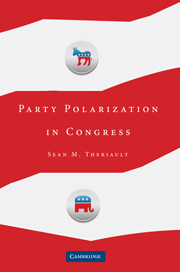Book contents
- Frontmatter
- Contents
- Acknowledgments
- 1 Party Polarization in the U.S. Congress
- PART I BUILDING BLOCKS FOR EXPLAINING PARTY POLARIZATION
- PART II CONSTITUENCY CHANGE
- PART III INSTITUTIONAL CHANGE
- 7 Connecting Constituency Change to Institutional Change
- 8 The Interaction in the Legislative Process
- 9 The Link between the House and the Senate
- 10 Procedural Polarization in the U.S. Congress
- Bibliography
- Index
9 - The Link between the House and the Senate
Published online by Cambridge University Press: 05 September 2012
- Frontmatter
- Contents
- Acknowledgments
- 1 Party Polarization in the U.S. Congress
- PART I BUILDING BLOCKS FOR EXPLAINING PARTY POLARIZATION
- PART II CONSTITUENCY CHANGE
- PART III INSTITUTIONAL CHANGE
- 7 Connecting Constituency Change to Institutional Change
- 8 The Interaction in the Legislative Process
- 9 The Link between the House and the Senate
- 10 Procedural Polarization in the U.S. Congress
- Bibliography
- Index
Summary
Upon his return to the United States, Thomas Jefferson, who missed the constitutional convention because he was in Paris serving as an ambassador, queried George Washington about why he ever accepted the aristocratic characteristics of the U.S. Senate. Washington was to have famously remarked: “We pour legislation into the senatorial saucer to cool it.” The framers, wary to draw too direct a line between the impulse of the people and public policy, created a complex lawmaking system to dampen the people's demands. Chief among these was the Senate. As Madison explains in Federalist 63, “Such an institution [as the Senate] may be sometimes necessary as a defense to the people against their own temporary errors and delusions.” Only the persistent and enduring demands from the people would enjoy a hearing and successful disposition in the Senate. By virtue of its design and practice over the past 220 years, the Senate has been less likely to be captured by the trends of the day than the House. As I show repeatedly throughout this book, however, even the Senate's tradition of comity and supermajoritarian requirements have not been able to preclude party polarization from pervading it.
Since the early 1970s, the Senate has polarized about 80 percent as much as the House. That the Senate has polarized almost as much as the House is surprising given that at both the electoral and the institutional levels, the House is more easily manipulated than the Senate.
- Type
- Chapter
- Information
- Party Polarization in Congress , pp. 196 - 217Publisher: Cambridge University PressPrint publication year: 2008



